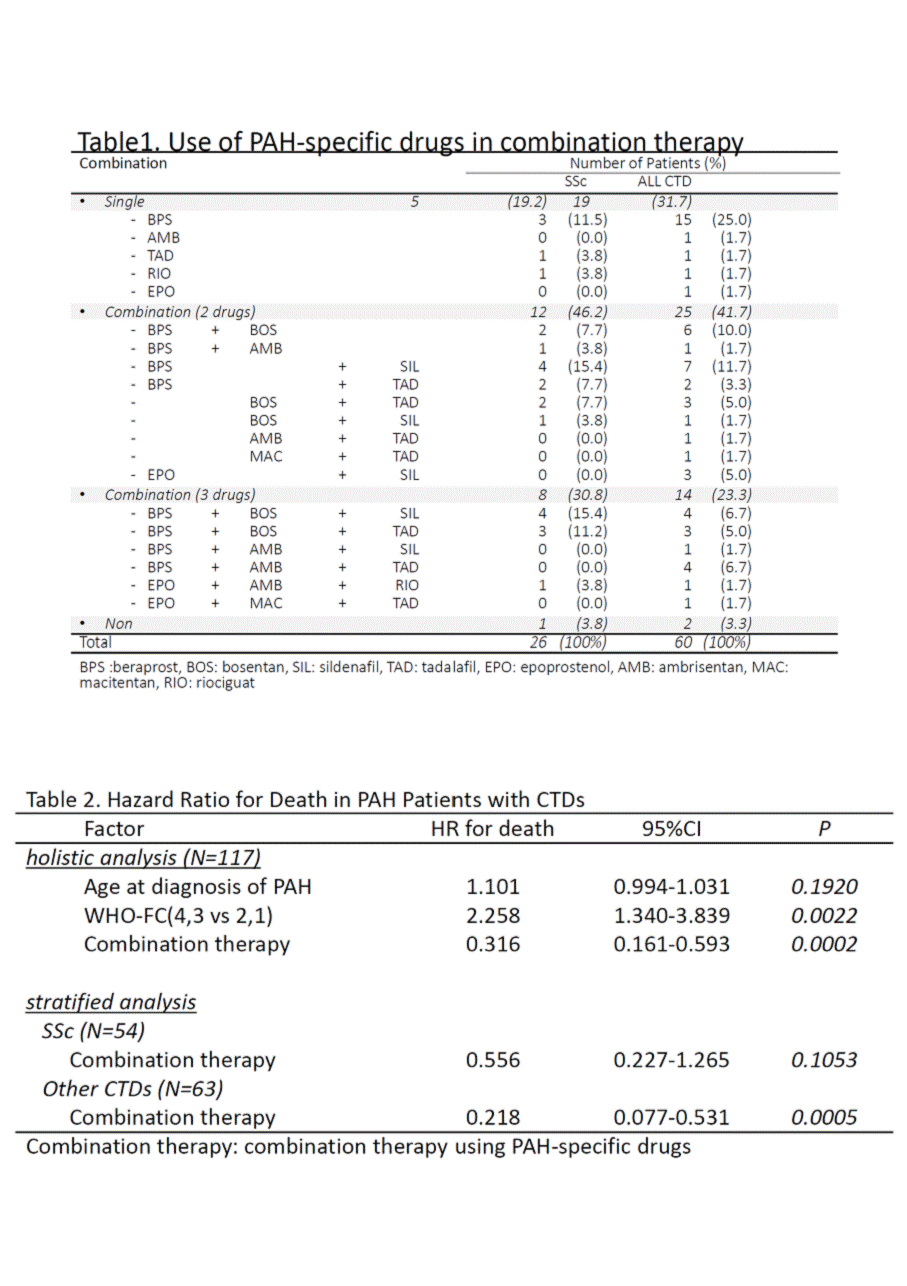Session Information
Session Type: ACR Poster Session B
Session Time: 9:00AM-11:00AM
Background/Purpose: Survival of patients with pulmonary arterial hypertension (PAH) associated with connective tissue disease (CTD), especially systemic sclerosis (SSc), is poorer than that of patients with idiopathic PAH. Notably, combination therapy using PAH-specific drugs has been recently shown to improve survival of patients with idiopathic PAH, In the present study, we evaluated survival of patients with PAH associated with SSc and other CTDs under PAH-specific drugs combination therapy.
Methods: We performed a retrospective-cohort study of 117 patients with PAH associated with CTD, including 54 SSc, 29 MCTD, 24 SLE and 10 other CTD patients, who were followed up between January 1980 and March 2016 in our hospital. PAH was diagnosed based on heart catheterization. Our combination therapy strategy for PAH intended to achieve the following goals: 1) improvement in WHO-functional class and 2) reduction of serum BNP level of less than 100 pg/ml, based on our previous study as well as on the results demonstrated by Hoeper et. al, (Eur Respir J 2005; 26: 858–863). The PAH-specific drugs, including bosentan, ambrisentan, macitentan, sildenafil, tadalafil, riociguat, epoprostenol, and beraprost (an oral prostacyclin analog that is only available in Japan), were switched from drug to drug or adopted in combination so as to achieve these predetermined therapeutic goals once a month. We performed Cox’s proportional hazard analysis for survival measured from the date of the diagnosis of PAH using propensity score (PS) methods. PS for combination therapy was estimated from a variety of factors and condition at the initial treatment for PAH using logistic regression.
Results: Sixty patients, including in 26 patients with SSc, were treated under our combination therapy strategy. The PAH-specific medications in this group at the last observation are shown in Table 1. Multivariate study demonstrated that combination therapy significantly reduced the risk for death (HR 0.316, 95%CI: 0.161-0.593) in patients with PAH associated with CTD. As shown in Table 2, stratified analysis revealed that combination therapy appeared to improve survival in PAH patients with SSc, although the efficacy was inferior to that in PAH patients with other CTDs.
Conclusion: The results demonstrate that combination therapy using PAH-specific drugs improved survival of PAH patients with both SSc and other CTDs. The data also confirm that the prognosis of PAH associated with SSc is worse than that of PAH associated with other CTDs. Further efforts are required for treatment of PAH associated with SSc.
To cite this abstract in AMA style:
Tanaka S, Matsueda Y, Abe G, Okada J, Hirohata S. Efficacy of Pulmonary Arterial Hypertension-Specific Drugs Combination Therapy in Survival of Patients with Pulmonary Arterial Hypertension Associated with Systemic Sclerosis and Other Connective Tissue Diseases [abstract]. Arthritis Rheumatol. 2016; 68 (suppl 10). https://acrabstracts.org/abstract/efficacy-of-pulmonary-arterial-hypertension-specific-drugs-combination-therapy-in-survival-of-patients-with-pulmonary-arterial-hypertension-associated-with-systemic-sclerosis-and-other-connective-tiss/. Accessed .« Back to 2016 ACR/ARHP Annual Meeting
ACR Meeting Abstracts - https://acrabstracts.org/abstract/efficacy-of-pulmonary-arterial-hypertension-specific-drugs-combination-therapy-in-survival-of-patients-with-pulmonary-arterial-hypertension-associated-with-systemic-sclerosis-and-other-connective-tiss/

